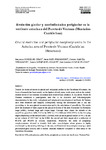Mostrar o rexistro simple do ítem
Evolución glaciar y morfodinámica periglaciar en la vertiente asturiana del Puerto de Ventana (Montañas Cantábricas)
| dc.contributor.author | González-Díaz, Benjamín | |
| dc.contributor.author | Ruiz-Fernández, Jesús | |
| dc.contributor.author | García-Hernández, Cristina | |
| dc.contributor.author | Menéndez Duarte, Rosana | |
| dc.contributor.author | González Díaz, José Antonio | |
| dc.date.accessioned | 2022-03-31T08:19:20Z | |
| dc.date.available | 2022-03-31T08:19:20Z | |
| dc.date.issued | 2021-12-31 | |
| dc.identifier.citation | GonzálezDíaz, B., Ruíz Fernández, J., García-Hernández, C., Menéndez Duarte, R., & González Díaz, J. A. (2021). Evolución glaciar y morfodinámica periglaciar en la vertiente asturiana del Puerto de Ventana (Montañas Cantábricas). Cadernos do Laboratorio Xeolóxico de Laxe. Revista de Xeoloxía Galega e do Hercínico Peninsular, 43, 101-134. https://doi.org/10.17979/cadlaxe.2021.43.0.8841 | es_ES |
| dc.identifier.issn | 2173-6936 | |
| dc.identifier.issn | 0213-4497 | |
| dc.identifier.uri | http://hdl.handle.net/2183/30331 | |
| dc.description.abstract | [Resumen] A pesar del avance reciente de los estudios sobre glaciarismo y periglaciarismo en las Montañas Cantábricas, el foco de las investigaciones se ha puesto en los conjuntos de mayor altitud, mientras áreas como el sector centro-occidental de la montaña asturiana han recibido menor atención. En este ámbito, el Puerto de Ventana constituye un área paradigmática debido a sus características altimétricas y litoestratigráficas. En este estudio se han identificado y cartografiado las formas de origen glaciar y periglaciar de la vertiente asturiana de dicho puerto, volcando posteriormente la información en un SIG y procediendo a la reconstrucción paleoglaciar y al cálculo de paleoELAs. Los resultados arrojan la existencia de tres fases en la evolución glaciar del área: Fase de Máxima extensión de los Hielos (MEH), Fase Interna y Fase de Circos. A través de estas fases, la altitud de las paleoELAs va pasando en función del método de los 1.400-1.557 en la MEH a los 1.515-1.649 y 1.650-1.838 m en las siguientes. Igualmente, a partir de una superficie glaciada inicial de 491,3 ha y un volumen de hielo de 510,7 hm3, la segunda y tercera fases muestran una reducción del 90,25 % y el 96,28 % del volumen, respectivamente. El estudio de la morfodinámica periglaciar, por su parte, ha permitido identificar morfologías relictas cuya génesis se encuentra altamente condicionada por la litología existente en el área, y geoformas funcionales de dinámica atenuada y marcado carácter estacional, en comparación con otras áreas de las Montañas Cantábricas. | es_ES |
| dc.description.abstract | [Abstract] Despite the recent advances in glacial and periglacial studies in the Cantabrian Mountains, the focus of research has been on the highest altitude areas, while areas such as the central-western sector of the Asturian mountain have received less attention. In this sector, Puerto de Ventana constitutes a paradigmatic area due to its altimetric and lithostratigraphic characteristics. In this study, both glacial and periglacial morphologies of the Puerto de Ventana have been identified and mapped, subsequently turning the information into a GIS and proceeding to the paleoglacial reconstruction and to the calculation of paleoELAs. The results show the existence of three stages in the glacial evolution of the area: Maximum Ice Extension Stage (MEH), Internal Stage and Cirque Stage. Through these phases the altitude of the paleoELAs goes from 1400-1557 in the MEH to 1515-1649 and 1650-1838 m in the following stages (depending on the method used). Likewise, from an initial glacial surface of 491.3 ha and an ice volume of 510.7 hm3 in the MEH, the second and third stages show a reduction of 90.25% and 96.28% in volume, respectively. Moreover, the study of periglacial morphodynamics allowed to identify both relict morphologies whose genesis is highly conditioned by the existing lithology in the area, and functional morphologies showing a weak geomorphological activity and a marked seasonal character compared to other areas of the Cantabrian Mountains. | es_ES |
| dc.description.sponsorship | Benjamín González Díaz agradece el apoyo al programa FPU del Ministerio de Educación, Cultura y Deporte de España para el desarrollo de sus investigaciones (referencia: FPU19/06583). Esta contribución estudia los temas de investigación tratados en el proyecto de investigación de excelencia PID2020-115269GB-I00 (MICINN, Gobierno de España) | es_ES |
| dc.language.iso | spa | es_ES |
| dc.publisher | Universidade da Coruña, Servizo de Publicacións | es_ES |
| dc.relation | info:eu-repo/grantAgreement//Plan Estatal de Investigación Científica y Técnica y de Innovación 2017-2020/FPU19%2F06583/ES/ | es_ES |
| dc.relation | info:eu-repo/grantAgreement/AEI/Plan Estatal de Investigación Científica y Técnica y de Innovación 2017-2020/PID2020-115269GB-I00/ES/DEGLACIACION Y RESPUESTA PARAGLACIAR DESDE EL ULTIMO MAXIMO GLACIAR EN LAS ISLAS SHETLAND DEL SUR (ANTARTIDA)/ | es_ES |
| dc.relation.uri | https://doi.org/10.17979/cadlaxe.2021.43.0.8841 | es_ES |
| dc.rights | Atribución-CompartirIgual 4.0 Internacional (CC BY-SA 4.0) | es_ES |
| dc.rights.uri | https://creativecommons.org/licenses/by-sa/4.0 | |
| dc.subject | SIG | es_ES |
| dc.subject | Paleoglaciares | es_ES |
| dc.subject | Formas y procesos periglaciares | es_ES |
| dc.subject | Puerto de Ventana | es_ES |
| dc.subject | GIS | es_ES |
| dc.subject | Paleoglaciers | es_ES |
| dc.subject | PaleoELAs | es_ES |
| dc.subject | Periglacial processes and landforms | es_ES |
| dc.subject | Ventana Pass | es_ES |
| dc.title | Evolución glaciar y morfodinámica periglaciar en la vertiente asturiana del Puerto de Ventana (Montañas Cantábricas) | es_ES |
| dc.title.alternative | Glacial Evolution and Periglacial Morphodynamics in the Asturian Area of Puerto de Ventana (Cantabrian Mountains) | es_ES |
| dc.type | info:eu-repo/semantics/article | es_ES |
| dc.rights.access | info:eu-repo/semantics/openAccess | es_ES |
| dc.date.updated | 2022-03-30T11:56:14Z | |
| UDC.journalTitle | Cadernos do Laboratorio Xeolóxico de Laxe. Revista de Xeoloxía Galega e do Hercínico Peninsular | es_ES |
| UDC.volume | 43 | es_ES |
| UDC.startPage | 101 | es_ES |
| UDC.endPage | 134 | es_ES |
| dc.identifier.doi | 10.17979/cadlaxe.2021.43.0.8841 |






